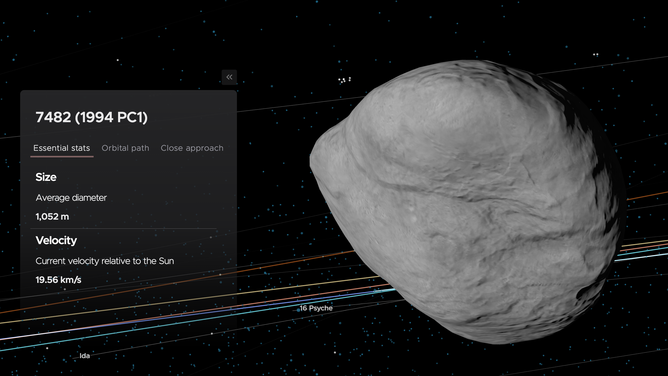Asteroid bigger than world’s tallest building passes ‘near’ Earth -- but no need to panic
Near-Earth Asteroid 7482, which is projected to pass our planet on Tuesday, is “very well-known and has been studied for decades” by NASA’s Planetary Defense Coordination Office

Asteroid 7482 is roughly 3,450 feet wide and will take a little over 1.5 years to orbit the sun.
(NASA's Jet Propulsion Laboratory)
There’s no need to worry, Earthlings.
Near-Earth Asteroid 7482, which is projected to pass our planet on Tuesday, is "very well-known and has been studied for decades" by NASA’s Planetary Defense Coordination Office. The asteroid is also known as 1194 PC1 in NASA's asteroid database.
"Rest assured, 1994 PC1 will safely fly past our planet 1.2 million miles away," NASA said.
A near-Earth object is classified as any space object that can come within 30 million miles of Earth. This asteroid’s closest Earth approach is roughly five trips to the Moon, which is 238,900 miles from Earth.
"One of the really cool things about a close-passing asteroid, like Asteroid 7482 (1994 PC1) is being able to watch as it soars past," said Dr. Susanna Kohler with the American Astronomical Society. "There are a ton of asteroids and comets out there, but the majority are so far away that we can’t see their motion in real-time. The fact that this one’s coming so close provides a unique opportunity to actually watch it move across the sky."
Kohler said people watching with a small backyard telescope should be able to see it zip across the background stars, moving a distance of 2 degrees — that’s four times the size of the full Moon on the sky.
"For those who don’t have their own telescope, there are lots of observatories that will be live-streaming the event on the internet as Asteroid 7482 (1994 PC1) passes," Kohler said.
You can click here to see thousands of asteroids and comets in real-time. You can also watch the next five close approaches to Earth, and explore past, present and future missions to asteroids and comets.

NASA's Asteroid Watch dashboard tracks asteroids and comets that will make relatively close approaches to Earth.
(NASA's Jet Propulsion Laboratory)
WHY 'ARMAGEDDON' PLOT IS NOT EARTH'S BEST DEFENSE FROM ASTEROIDS
Discovery of Asteroid 7482
Asteroid 7482 is roughly 3,450 feet wide (a length of roughly 10 city blocks) and will take a little over 1.5 years to orbit the sun. For perspective, the world’s tallest building, Dubai’s Burj Khalifa, is 2,716.5 feet tall.
On Aug. 9, 1994, it was discovered by R.H. McNaught at Siding Spring Observatory in New South Wales, Australia.
"We can look back even further in archival astronomical data and find observations of Asteroid 7482 (1994 PC1) dating back as far as 1974. With 47 years of observations in hand, we can make a very good prediction of its precise orbit, which means we know with confidence that it won’t hit Earth," Kohler said.
Experts with the PDCO oversee tracking NEO that comes within 5 million miles of Earth; these are known as potentially hazardous objects – which this asteroid is grouped.
"To put this into perspective, there have been fewer than 15 known instances of large asteroids — those with a diameter of more than a third of a mile or so — coming within 1.2 million miles of the Earth in the last century," Kohler said.
That said, just wait until the year 2027.
Asteroid 137108 (1999 AN10) will be swinging by on Aug. 7 2027, and it’ll get even closer – just 240,000 miles away, Kohler said.
The asteroid 1994 PC1 is also classified as an Apollo asteroid, meaning the Earth-crossing NEA has a semi-major axis larger than Earth’s.
Astronomers designated it as an S-type asteroid, a relatively common type of asteroid that has a dense composition made up of stony materials like iron- and magnesium-silicates.
"Like most asteroids, it’s spinning as it travels, rotating once every 2.6 hours or so," Kohler said.
NASA's DART mission
NASA’s NEO Observation Program aims to find, track, and learn about 90 percent of NEOs that are larger than 140 meters. So far, more than 40 percent of these asteroids have been found, according to NASA.
If one of these asteroids were to come close, the PDCO would alert the government and the public.
According to the PDCO, there is a greater than 1% chance of this happening over the next 50 years.
When the time comes, there is an international plan underway to learn how to deflect a massive space rock.
On Nov. 24, 2021, a SpaceX Falcon 9 rocket launched NASA's Double Asteroid Redirect mission known as DART from Vandenberg Air Force Base in California. Unlike most NASA spacecraft missions, DART has a short lifespan and is designed to test out a planetary-defense method that could one day save Earth.
7 THINGS TO KNOW ABOUT NASA’S DART MISSION
NASA plans to use the Double Asteroid Redirect, or DART, spacecraft as a battering ram to crash into a near-Earth asteroid and see if the kinetic energy can change its direction by a tiny amount.
NASA'S DART SPACECRAFT LAUNCHES ON MISSION TO INTENTIONALLY SMASH INTO ASTEROID
It’s the first mission of its kind and part of an international collaboration to protect Earth from asteroid impacts.
The $330 million mission: smash into the small moonlet Dimorphos orbiting a larger 780-meter asteroid called Didymos. If all goes well, DART will smash into the asteroid in fall 2022.